
 |
|
|
#61 |
|
Member
Join Date: Dec 2004
Location: Sweden
Posts: 1,637
|
Thanks for the explanation of the stingray whip.
Please develop the relationship between horn and croc's eyes as I didn't get it? Here is a link to the seller's pictures of one of my bolos with talismanic motifs. http://www.mytribalworld.com/pagina12.html My guess is that it's Visayan. Any other ideas on the origin and/or the meaning of the motifs on the blade? Michael |
|
|

|
|
|
#62 |
|
Member
Join Date: Dec 2004
Location: Witness Protection Program
Posts: 1,730
|
sorry for the misunderstanding. i meant to say that regarding the croc's eyes on the kampilan, i haven't seen any that utilized horns for its eyes. normally it's some sort of metallic discs...
as far as your sword: wow, that's a beauty! it's an enigma as well since it has attributes from different sources. the blade has visayan flavor (beveled edge), and even the handle appears to be a bakunawa. the patterns on the blade is something i've never seen on any visayan blades tho. it appears lumad. michael, if there's anyone that could prolly help you on this, i would say manong leo gaje could. i'm sorry i couldn't be much of help. |
|
|

|
|
|
#63 |
|
Member
Join Date: Dec 2004
Location: Sweden
Posts: 1,637
|
Thanks,
On talismanic inlays, as well as other spiritual matters, in most cultures it's usually considered stronger if it's foreign. So maybe this is the case? A visayan sword with Lumad (inspired or copied?) engravings? Maybe someone else recognise something on this blade? Do you think the blade motifs might be related to (evil) eyes or is it something else? Michael |
|
|

|
|
|
#64 |
|
Member
Join Date: Dec 2004
Location: Witness Protection Program
Posts: 1,730
|
hi michael,
i was looking at one of my binangons and i remember this unusual feature: this binangon: http://www.arscives.com/historysteel...s1/202-rz6.jpg  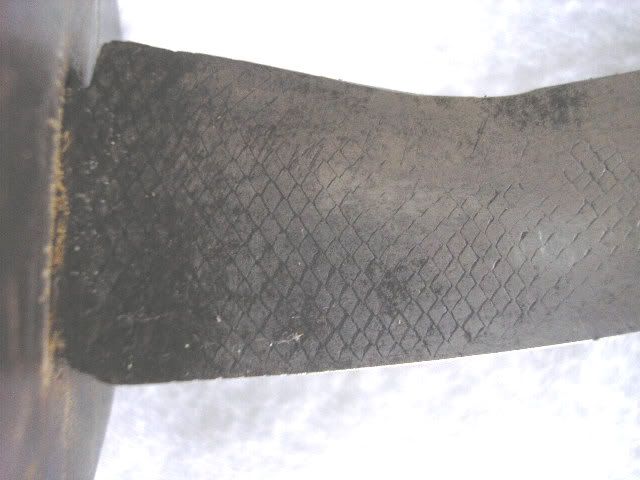 at first glance, it could be assumed that a hugh rasp file (at least 20" by 2.5")was used as blank to make the blade. granted it was, but why not grind it until there's no sign that it was a rasp file? or was it left there on purpose? remember; bakunawa = dragon  here's a motif from a recent kris that i haven't cleaned yet: 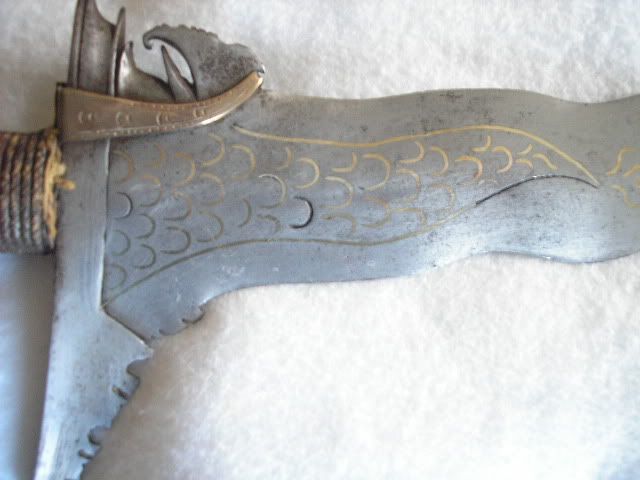 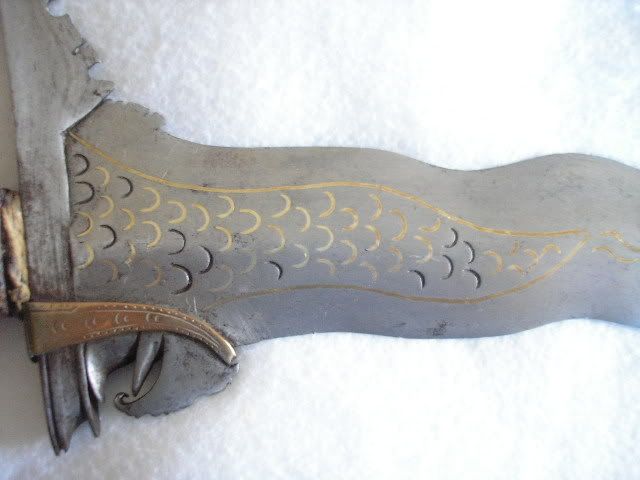
|
|
|

|
|
|
#65 |
|
Member
Join Date: Dec 2004
Location: Sweden
Posts: 1,637
|
Hi Ron,
Bakunawa and scales is an interesting idea that I haven't heard of before. Here are some new pictures of the bolo I only had a link to before. Michael |
|
|

|
|
|
#66 |
|
Member
Join Date: Dec 2004
Location: Witness Protection Program
Posts: 1,730
|
without a doubt, it is a bakunawa, more pronounced than the Ilonggo version. thanks for the close ups. the lean on the blade is something i find unusual. pretty cool, tho.
|
|
|

|
|
|
#67 |
|
Member
Join Date: Dec 2004
Location: Sweden
Posts: 1,637
|
Here is a motif I haven't seen on kris blades before - the star cluster.
It was a pleasant surprise as the pictures on ebay was of a very low quality so it was impossible to see what the blade really looked like. Also an unusual hanger attached to the scabbard on this Maranao kris. The hilt and scabbard however aren't that exciting. Any ideas or references for this motif? Michael |
|
|

|
|
|
#68 |
|
Member
Join Date: Apr 2005
Posts: 3,255
|
Congrats, Michael!
The blade looks Sulu to me - hilt possibly Maguindanao? This "star" motif seems to be related to the smaller "stars"/"bird footprints" sometmes seen on older Moro blades. A thumbnail of a really nice example is published in vZ (sundang)... The small peg for holding the scabbard in the sash seems to be quite common with these Maguindanao scabbards. Regards, Kai |
|
|

|
|
|
#69 |
|
Member
Join Date: Dec 2004
Location: Sweden
Posts: 1,637
|
Maybe I was too fast with describing the blade as Maranao?
I went for the Cato classification but I agree that the rest looks more Sulu. On the van Z thumb nail picture I can't really see if it's stars or the more common dots? Do you have any other reference picture? Michael |
|
|

|
|
|
#70 |
|
Member
Join Date: Dec 2004
Location: What is still UK
Posts: 5,925
|
I do not know if this has any relevance but flowers-gardens-paradise, and stars-heaven, are all often elements in Islamic carpet design and other decoration.
|
|
|

|
|
|
#71 |
|
Member
Join Date: Dec 2004
Location: Witness Protection Program
Posts: 1,730
|
hi michael,
thanks for posting that. are the stars in any particular pattern going down the blade? as per the scabbard; prolly not original to the blade... |
|
|

|
|
|
#72 |
|
EAAF Staff
Join Date: Dec 2004
Location: Louisville, KY
Posts: 7,346
|
I agree with Kai in that the blade looks Sulu but the rest is Maguindanao.
Also the "fingernail" symbols are an old okir motif, used in both Maranao/Maguindanao and Sulu pieces. These seemed to have migrated to the Lumad tribes as well who live near the Maguindanao and Maranao. The tool that makes this symbol is easy to make and common to chasing tools all over Indonesia and the PI. |
|
|

|
|
|
#73 |
|
Member
Join Date: Dec 2004
Location: Sweden
Posts: 1,637
|
Thanks all for comments,
On the "stars" they are single on the katik area and then along the fuller it's 5-formations with a single star inbetween (1+5+1+5+1 etc.). On the scabbard and hilt I also suspect that they are later than the blade. Michael |
|
|

|
|
|
#74 |
|
Member
Join Date: Dec 2004
Location: What is still UK
Posts: 5,925
|
This link is interesting. There is a warning not to see what you want to see, {scroll down to sub title "The Paradise Show"} but this kind of imagery appears frequently on these weapons. We know the back ground and setting, also that the peoples are Muslim, that weapons, warriors, jihad, death and martyrdom often go hand in hand with faith and paradise. Mottos and talismans of a religous nature are common on edged weapons the world over. It is not unreasonable to consider exploring possible links to "higher?" depictions of paradise in Islamic art and architecture.
http://www.sonic.net/~tallen/palmtree/ip.html Last edited by Tim Simmons; 15th February 2009 at 11:44 AM. |
|
|

|
|
|
#75 |
|
Member
Join Date: Dec 2004
Location: Sweden
Posts: 1,637
|
Thanks Tim,
Some symbols, like Ali's sword, probably don't have that many probable interpretations? But for a star, or a star formation of five, it's quite open. Both the star in itself, that could maybe symbolise something celestial, and the number 5 have a lot of possible explanations: - the 5 palaces of Malay metaphysics - heart, stomach, liver, lungs and the complete body? - the 5 daily prayers? - 5 fingers in your eye, against the evil eye? - the old Hindu-Malay divination system of the 5 times of the day and the 5 days - Katika Lima? - maybe Paradise somehow or maybe something else? I am open and curious for suggestions. Michael |
|
|

|
|
|
#76 | |
|
Member
Join Date: Dec 2004
Location: Witness Protection Program
Posts: 1,730
|
Quote:
another angle could be perhaps it's not not talismanic, rather just some patriotic decor. |
|
|
|

|
|
|
#77 | |
|
Member
Join Date: Nov 2006
Posts: 400
|
Quote:
I think its ( the motis on page 1 with cirlces and arrows) more or less related to a symbol what know in old works as " the headhunting symbol" . It looks like a split of the whole symbol maybe course it has lost its original meaning. The headhunting symbol is widespread and the most clear in the Ceram and Celebes culture where in the motif 4 birds flying away from the sun. ( the cirlce) The birds are in some cultures replaced by halfmoon motifs , half moon motifs are on their way connected with the horn motif a fertility symbol. The sun wich is coming up and going down is the symbol of live and death. combing these two symbols in one motif these kind of motifs are very old and used as symbols around headhunting. Source: Toovertekens en symbolen van Indonesie - G.L.Tichelman. Arjan. |
|
|
|

|
|
|
#78 |
|
Member
Join Date: Dec 2004
Location: Sweden
Posts: 1,637
|
Thanks both Ron and Arjan for sharing your knowledge.
As well as giving me new ideas on the meaning of the motifs of both the last and the first kris of this thread. Michael |
|
|

|
|
|
#79 |
|
Member
Join Date: Dec 2004
Location: What is still UK
Posts: 5,925
|
There are so many stars I cannot see the 5 star thing. I am not an expert acedemic but what I can see is a floral motif capped by a pattern of stars done in a most sensitive and economical manner in a confined space, so clever -beautiful in fact. If it does not represent paradise under the celestial sky? it is indeed very simple to read it so, one might think it was almost deliberate.
Last edited by Tim Simmons; 16th February 2009 at 07:22 PM. |
|
|

|
|
|
#80 |
|
Member
Join Date: Dec 2004
Location: Sweden
Posts: 1,637
|
Tim,
The floral motif is quite common on Sulu kris. Bill has earlier posted a very nice kris with this motif. It seems to be a symbol for the sultanate? The 5 stars are lower on the blade, inside and along the fuller. Michael |
|
|

|
|
|
#81 |
|
Member
Join Date: Dec 2004
Location: What is still UK
Posts: 5,925
|
There are still lots more stars? is the Sultan a Muslim? is the Sultanate Islamic? Perhaps the inclusion of the Sultan stars is some suggetion to ideas of an Islamic paradise/state on earth? is the 5 star configuration just a help with the overall decorative affect? No answers, but I think this is far from just random pretty sword decoration, it is purposeful. I think the artist would want other people to very quickly understand the imagery?
Last edited by Tim Simmons; 16th February 2009 at 09:16 PM. |
|
|

|
|
|
#82 |
|
EAAF Staff
Join Date: Dec 2004
Location: Louisville, KY
Posts: 7,346
|
The 5 star pattern could represent the Sulu Sultanate, which uses 5 stars on the flag to represent the 5 territories under it's control at the time.
|
|
|

|
|
|
#83 |
|
Member
Join Date: Dec 2004
Location: What is still UK
Posts: 5,925
|
It is possible to see a pattern of 7 stars. One either side of the tighter group of 5. If the 5 stars patterns are to represent the Sultanate I see no conflict in a depiction of paradise. I just think it is very cleverly done such a lot of information in such a small space and still beatiful.
|
|
|

|
|
|
#84 |
|
Member
Join Date: Dec 2004
Location: What is still UK
Posts: 5,925
|
Scroll down to Paradise, lots of high art pictures in this site but does include Islam east of India?
 http://www.patterninislamicart.com/b...ous-dimension/ |
|
|

|
|
|
#85 |
|
Member
Join Date: Nov 2005
Posts: 341
|
I think this inscription is not for decoration ( its hardly visually beautiful).
The inscription is also not talismanic I think i.e. its not magic The inscription is also not an encoded message. In my opinion the inscription is purely symbolic and is not designed for others to understand but rather it was to remind the original owner of a concept or knowledge which was important to them personally. |
|
|

|
|
|
#86 |
|
Member
Join Date: Dec 2004
Location: What is still UK
Posts: 5,925
|
It is the the simple graphics fitting the form that is the beauty for me, perhaps a reminder of a passionate nocturnal outdoors encounter
 http://science.jrank.org/pages/10606...iterature.html |
|
|

|
|
|
#87 |
|
Member
Join Date: Dec 2004
Location: Witness Protection Program
Posts: 1,730
|
here's a barung that has some neat squiggly lines inlaid in brass on both sides. i like this one since it's almost as if she's telling me a story. well, than and one of the most intricate handle carvings i've seen. which matches the squiggly lines on the blade.
 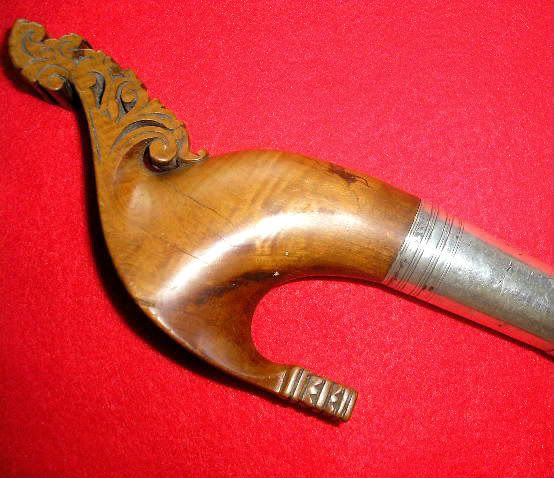 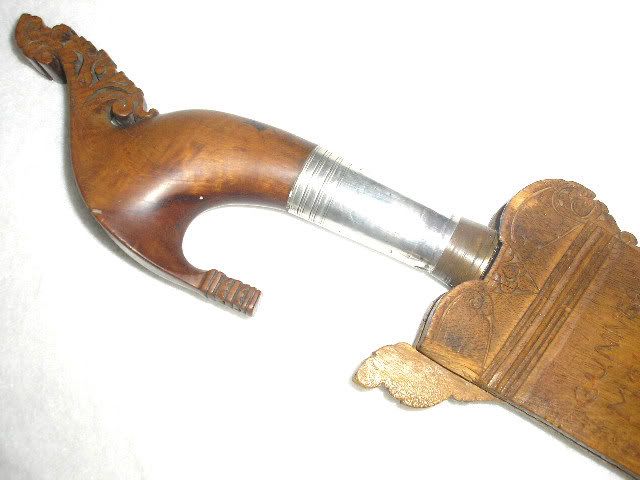    ...and to answer your question, tim; yes, the moros are muslims |
|
|

|
|
|
#88 |
|
EAAF Staff
Join Date: Dec 2004
Location: Louisville, KY
Posts: 7,346
|
I see a stylized okir naga on the blade - nice.

|
|
|

|
|
|
#89 |
|
Member
Join Date: May 2008
Posts: 58
|
are this naga? or dragons supposedly? thnks.
bad photo, sorry. Last edited by hideyoshi; 21st February 2009 at 01:22 AM. |
|
|

|
|
|
#90 |
|
Member
Join Date: Dec 2004
Posts: 1,021
|
WOW! 2 beautiful Barung's. Love those blades.
Spunjer that pommel looks huge. Hideyoshi, can you post a photo of the whole Barung. Here is one of mine that I had posted earlier. The inlay of mine looks like a centipede. What happened to the Moro tenet that images of animals were prohibited. 
|
|
|

|
 |
|
|